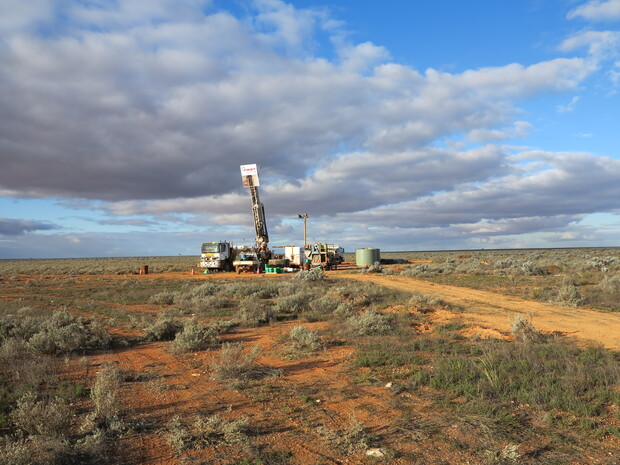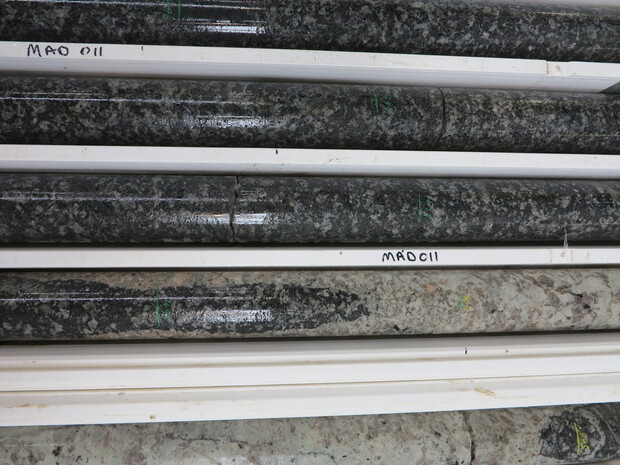The Eucla basement project was established to investigate the greenfields basement provinces that lie between the eastern edge of the Albany–Fraser Orogen and the western margin of the Gawler Craton in South Australia.

In Western Australia these basement provinces are the Madura Province and the Forrest Zone of the Coompana Province. They are covered by up to 300 m of younger basin rocks of the Cretaceous Madura Shelf, which is overlain by up to 200 m of Eocene limestone sequences of the Eucla Basin, forming the Nullarbor Plain. The lack of exposure of any Precambrian rocks means the project is totally reliant on geophysical data interpretation and drillcores.
The Eucla basement stratigraphic drilling program, funded through the Exploration Incentive Scheme (EIS), was established to provide high-quality diamond cores of the basement from well-defined geophysical domains. The results of the drilling program were presented at a public workshop in September 2015. Topics included:
- drilling techniques and core acquisition
- lithological and structural features
- sulfides, veins and alteration
- implications for geophysical data interpretations
- geochronology
- geochemistry, isotopes and crustal evolution
- tectonic settings and implications for geodynamics and prospectivity
- geology of the cover sequences.

The presentations are available in the table below. Extended abstracts and Whole-rock major and trace element geochemistry data on diamond drillcore samples from the Madura Province and Forrest Zone (Excel table) are also available. Whole-rock assay data on diamond drillcore altered samples from the Madura Province and Forrest Zone (Excel table) are available here.
The drilling program has provided a wealth of new data and increased our knowledge of the basement provinces that are missing links in understanding Proterozoic Australian geology. Combined with work on existing EIS co-funded and donated company cores, the new drillcores also provide insight into the prospectivity of the vast region that lies beneath the Nullarbor Plain.
The stratigraphic drilling program has also provided valuable experience and knowledge of the challenging ground conditions associated with drilling in the Nullarbor region. Both RC and mud-rotary techniques have been trialled and assessed as alternative techniques for getting through the cover to basement, which was intersected at depths between 250 and 440 m.
Eucla–Gawler deep crustal seismic reflection and MT surveys
In 2013–14 the 13GA-EG1 reflection seismic and MT surveys were acquired as part of a cross-border collaboration between the Geological Survey of Western Australia, the Geological Survey of South Australia and Geoscience Australia.
| Presentation | Presenter | Organisation |
|---|---|---|
| Welcome and introduction | Ian Tyler | GSWA |
| Cenozoic Record Eucla Basin | Mick O’Leary | Curtin University |
| Pre-Cenozoic stratigraphy: basin and margin evolution | Milo Barham | Curtin University |
| Drilling Techniques | Paul Mander | First Drilling |
| Madura Lithology and Structure | Catherine Spaggiari | GSWA |
| Madura U–Pb Geochronology | Michael Wingate | GSWA |
| Madura Geochemistry and Petrogenesis | Hugh Smithies | GSWA |
| Madura Isotopes and Crustal Evolution | Chris Kirkland | Curtin University |
| Forrest Lithology and Structure | Catherine Spaggiari | GSWA |
| Forrest U–Pb Geochronology | Michael Wingate | GSWA |
| Forrest Geochemistry and Petrogenesis | Hugh Smithies | GSWA |
| Forrest Isotopes and Crustal Evolution | Chris Kirkland | Curtin University |
| Geodynamics and prospectivity | Catherine Spaggiari | GSWA |
Contact
For more infromation contact:
geological.survey@dmirs.wa.gov.au
